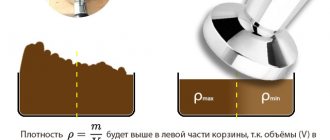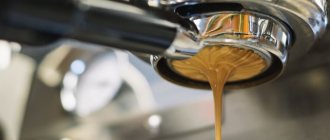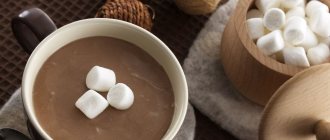Instant coffee, of course, is a convenient thing, but it cannot be compared with fragrant espresso, decorated with lush foam. Real gourmets buy a carob coffee maker for home or office, which prepares just such an aromatic drink.
It got its name - carob - due to the fact that coffee powder is poured into a special horn, then compacted and treated with steam.
Due to this, ground coffee releases about a quarter of the aromatic substances (if the steam pressure is sufficient), and the resulting drink pleases with its strength and wonderful aroma. Next, let's talk about how models of carob-type coffee makers, or espresso coffee makers, as they are often called, differ from each other.
Carob coffee maker pressure
The simplest and most inexpensive devices (they are called Steam-Espresso) with a power of up to a thousand watts can develop a pressure of no more than 4 bar. In this case, water in a sealed container is heated to a certain temperature, pressure is built up, and then a valve opens, through which hot steam flows to the horn and is passed through the coffee powder.
Unfortunately, some of the aromatic substances are destroyed by steam with this method, but this drink contains a lot of caffeine. A cup of coffee takes about two minutes to prepare, no more.
Higher-class coffee makers (Pump-Espresso) have a power from 1000 to 1700 watts, the steam pressure in them can reach 15 and even 25 bar. Their design is based on an electric pump with a thermoblock that does not allow the water to heat above 95 degrees.
High pressure forces steam through the ground coffee particles, allowing them to fully reveal their aroma and taste. The speed of preparing a cup of coffee is half a minute.
Operating pressure of the coffee machine
On some devices you can find a reading from 15 to 20 bar. This is the operating pressure of the pump. At the outlet, that is, in the horn, it is 8 - 9 bar. This is the optimal indicator at which you get delicious espresso with foam. If you imagine that the water will flow under a pressure of 15 - 20 bar, then at this pressure in the coffee machine, espresso simply will not be prepared, since the liquid will simply fly out through the horn without having time to extract all the substances from the ground grain.
The opposite process: a pressure of 5 - 6 bar will also not prepare the drink, because it is too small to “squeeze” essential oils out of the beans in 30 seconds, even with very hot water. Therefore, the answer to what pressure or how many bar should be in a coffee machine is one: 8 - 9. All manufacturers of good machines try to increase the pressure to 9 bar at the outlet of the horn. Everything else is distributed among other nodes in the unit.
Video: General coffee machine settings
Cappuccino maker in a carob coffee maker
Those who love cappuccino and lattes should choose a coffee maker with a cappuccino maker. It can be either mechanical (for cheaper models) or automatic (for professional coffee makers).
The mechanical device is a tube with a tip for releasing steam, which is dipped into cold milk and the foam is whipped. A little trick: to make the foam whip up easily, it is recommended to slightly sugar the milk.
An automatic cappuccino maker is more convenient: just pour milk into a special container and press a button. For some models, the thickness of the foam can be varied.
There are models where coffee and cappuccino can be prepared at the same time: the coffee maker has two pumps.
Why does equipment break down?
Conventionally, all breakdowns can be divided into two groups.
The first includes:
- factory defect - there is a scheme for returning the device back;
- lack of timely preventive examination;
- incorrect settings of the coffee machine - I advise you not to neglect reading the instructions;
- mechanical damage, incl. falls, blows. Most often this occurs due to improper transportation;
- wear and expiration of components and parts.
The second group is:
- the use of low-quality grain is an extremely common cause of breakdown;
- lack of cleaning - provokes failure of the heating elements;
- operation of the machine at low temperatures - you can count on problems with the hydraulic system and defrosting of the drainage system;
- power surges , forced shutdown of the coffee machine, unexpected power outage - the control board often flies;
- overload - if you choose a device without calculating the performance, there is a possibility of almost continuous operation, which will damage the machine.
Additional functions of carob coffee makers
- To make good coffee, your espresso coffee maker must have a tamper. The material from which it is made is unimportant. The mass of powder is compacted tightly, but without unnecessary fanaticism - otherwise the steam will not be able to pass through the coffee particles.
- Some models of coffee makers are equipped with a built-in coffee grinder. This is not bad - you can immediately grind the required amount of powder. In addition, you can set the desired degree of grinding. Such models often have a very convenient function for automatically preparing a coffee “tablet”.
- Some devices do not use ground coffee, but so-called “pods”, or tablets - compressed seven-gram packs of coffee powder, packed in a filter and the size of a cone. This eliminates the need to wash the horn and measure out the required dose of coffee. But such coffee grinders are more expensive to operate.
- The waste container is useful when it is not possible to wash the cone right away. This container is enough for 10-15 servings.
- Devices such as control of coffee strength, the “fast steam” function (allowing you to instantly switch from brewing coffee to whipping foam and back), a pressure gauge, and a water level sensor will also not be superfluous.
- It’s good if there is heated cups - after all, coffee does not like cold dishes - this is an immutable rule. The cups are heated to 40 degrees – this is optimal.
Do you want to brew coffee where there is no electricity? A geyser-type coffee maker will help you with this!
Do you want to lose weight and love tea? You can read about how helba helps with weight loss here.
Did you know that pu-erh is also called earth tea? If not, then visit this page: https://ahotcup.com/chai/puehr/vse-o-chae-puehr-i-ego-dejjstvii-na-organiz.html.
Tips for choosing
- The most important characteristic of a professional coffee machine is the degree of automation of processes. Semi-automatic machines are suitable for establishments that employ experienced professionals, since in this case the quality of coffee is greatly influenced by the human factor.
- In other places - small coffee shops, for example, it is better to install vending machines. They independently perform all operations; the service personnel only select the program.
- Pay attention to the installation method of the machine. Built-in models take up little space and are suitable for small spaces. But such devices are more expensive than regular ones, so if you have free space, it is more profitable to buy a separate machine.
- When buying a coffee machine, you should pay attention to additional functions: protection against overheating, a counter for the number of cups prepared, grinding adjustment, etc. They increase the safety of use and the quality of the drink.
- For large coffee shops, it is advisable to choose a coffee machine with a direct connection to the water supply. Otherwise, you will have to install a huge container of water next to the device and constantly worry about filling the hopper.
What you should pay attention to when buying a carob coffee maker
- To obtain an aromatic drink with excellent taste, the power of the device must be at least a kilowatt, and the declared pressure must be at least 15 bar. Coffee makers with low pressure (up to 4 bar) brew stronger coffee with a high caffeine content.
- Check the kit for the presence of a tamper.
- The horn is preferably metal. Ideally - steel, if finances are limited - silumin.
- If you are going to make lattes and cappuccinos, choose a model with a cappuccino maker.
- The built-in coffee grinder will help save time and allow you to get the desired grind.
- Models with heated cups, a waste container, automatic preparation of coffee “tablets” and an automatic cappuccino maker are convenient for the office.
- Popular manufacturers: Philips, Bosch, Delonghi, Krups.
How to choose a coffee maker
Coming to the store and not knowing anything about the design of coffee makers, people are lost in the range and technical indicators. Sellers, of course, are trying to sell a product from a higher price segment, but people need a carob coffee maker for home use. So the main task will be to choose a device that meets the technical characteristics of delicious espresso:
- The pressure in the coffee machine must be at least 8 bar. Anything less will cost less, but will not work well. You cannot save on a pump if everyone in the family is a coffee lover.
- A large boiler volume is an important indicator if you need to cook many portions in a row. This will allow the device to consistently supply boiling water and steam to the cappuccino maker.
- Unit power. Affects the rate of heating of water in the boiler.
Sellers may say that the higher the pump pressure, the better. 15 bar of pressure for a coffee machine is normal, but this is the maximum potential value. The output will still be 9 bar. Buying a device based on these parameters is like buying a sports car with a potential speed of 350 km/h to drive through city traffic jams.
The best carob coffee makers will cost at least $500 in foreign currency. It is not recommended to buy cheaper units, since the drinks will be watery, without foam, and you will have to go to a bar to drink normal coffee and spend additional money on it.
Pump and boiler pressure
The pressure sensor in the boiler indicates overheating of the equipment or the onset of operating mode. In the latter case, the sensor moves the arrow to the green zone. During operation, the pressure level may decrease, then you need to wait until the indicators stabilize so that the equipment returns to operating parameters. With modern equipment this happens very quickly.
The pump pressure sensor in the coffee machine indicates deviations in the parameter from the norm.
If the pressure does not match
At low pressure, the coffee turns out to be of lower quality, and foam does not form. Therefore, it is important to monitor this parameter. Although modern coffee machines do this on their own, only signaling to the user if something goes wrong.
Therefore, you should try to initially purchase a coffee machine from a well-known manufacturer, which will simplify the task of making coffee, and make the procedure pleasant and effective. The coffee will definitely turn out tasty, aromatic, and healthy. And for this, it is advisable to immediately decide what drinks will be prepared. This will help you choose either a simple model or a device with advanced capabilities that allow you to prepare several types of coffee drinks at once.
Source
Options
What is the maximum pressure in a modern coffee machine? 15 bar is far from the “ceiling”. For example, Cremesso capsule devices are characterized by a pressure of 19 bar. This level can provide foam of sufficient density, while maintaining the taste and aroma of the drink. This ensures a temperature of 92 degrees. Under the influence of such conditions, the bottom of the capsule bends, which is pierced by special spikes, due to which the liquid enters the cup.
Separately, it is necessary to say why the pressure of 15 bar is so often remembered. This level is set for preparing classic espresso. The water heats up to 92 degrees. This ensures a high speed of preparation of the drink - about 30 s.
So, here are the parameters to ensure the conditions for preparing classic espresso:
Pressure gauge failure
Modern coffee machines are equipped with two pressure gauges - a pump and a boiler . They can be placed in one block or separately. The boiler pressure gauge controls temperature and pressure, it notifies that the device has reached operating condition - the same 1.1-1.5 atm. If the car has one pressure gauge, this thing works for the boiler.
The pump pressure gauge controls the pressure in the brew group. The operating parameters in this case correspond to 9 atm . Deviations from the norm indicate a breakdown.
Causes:
- tubes are clogged with scale (solution: cleaning or replacing with a new one);
- clogging the channels leading to the pressure gauge;
- pressure gauge failure.
Solution : replacement of the unit or tubes at a service center, decalcification.











